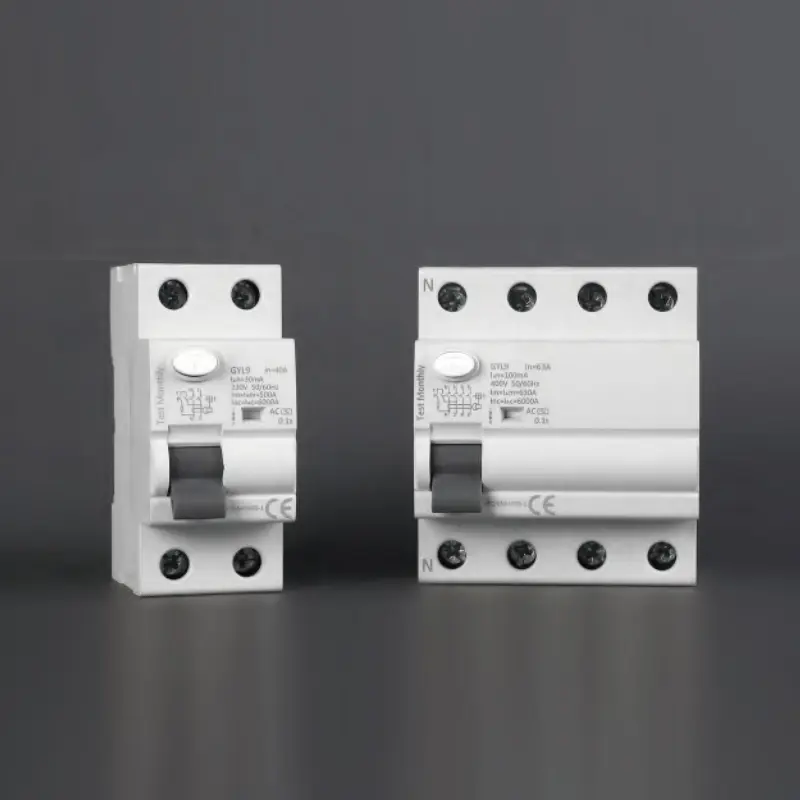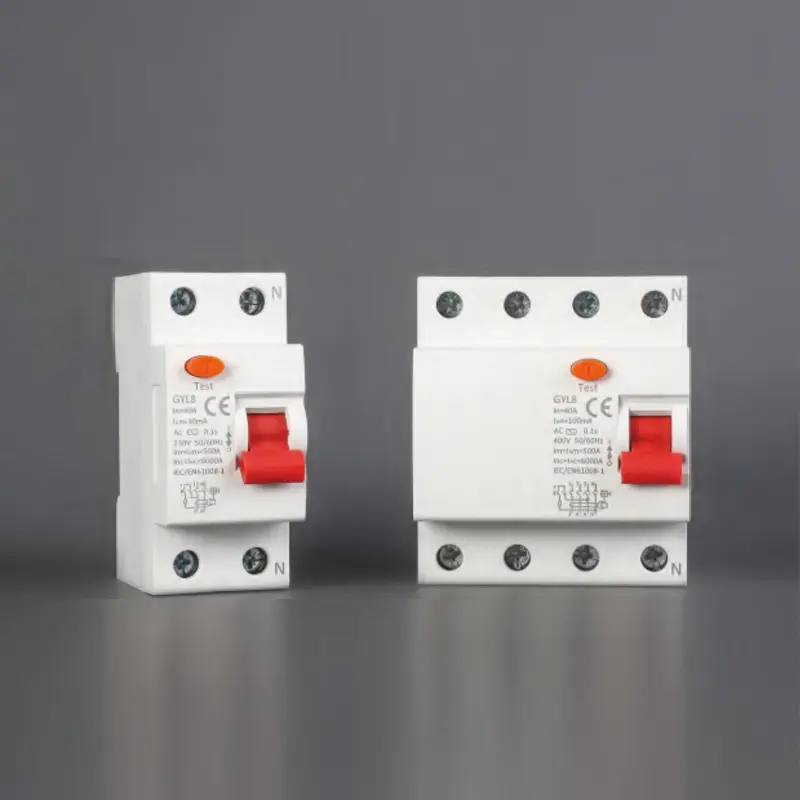Table of Contents
1. What is RCCB?
RCCB (Residual Current Circuit Breaker) is an essential electrical protection device designed to detect leakage currents in electrical circuits. When it detects a leak, it quickly disconnects the power supply, thereby protecting personal safety and preventing electrical fires. The RCCB operates based on monitoring current balance; it will respond immediately if it detects an imbalance between the current flowing through the live wire and the neutral wire.
1.1 Historical Background
The concept of leakage protection emerged in the early 20th century, but the RCCB, as a standardized electrical protection device, became widely used only in the mid-20th century. With the increasing prevalence of electrical equipment, there has been a growing emphasis on electrical safety. The use of RCCBs has become a crucial means of safeguarding personal safety. Today, RCCBs are indispensable components of modern electrical systems.
2. Working Principle of RCCB
The working principle of an RCCB is straightforward yet effective, primarily relying on its internal current monitoring mechanism. It continuously monitors the flow of current in the circuit to ensure it remains within safe limits.
2.1 Current Monitoring
RCCBs are equipped with current transformers that measure the current flowing through the live and neutral wires. Under normal conditions, the current in both wires should be equal. However, if there is a leakage current to the ground or another abnormal path, an imbalance will occur.
2.2 Leakage Detection
Once the RCCB detects an imbalance in the current, it will quickly disconnect the power supply. Typically, when the leakage current reaches a certain threshold (e.g., 30mA), the RCCB will activate immediately. This rapid response effectively prevents electric shock incidents caused by leakage, ensuring personal safety.
2.3 Disconnection Mechanism
The internal mechanism of an RCCB includes an electromagnetic switch and a reset device. When leakage is detected, the electromagnetic switch is triggered, disconnecting the circuit. The design of the entire mechanism ensures that in the event of an electrical fault, the power can be cut off within milliseconds, thereby reducing the risk of accidents.
3. Types of RCCB
RCCBs can be classified in various ways to meet different application requirements.
3.1 By Rated Leakage Current
RCCBs are categorized based on their rated leakage currents, which include:
- 30mA: Suitable for protecting human safety, commonly used in residential and public places.
- 100mA: Used for equipment protection, suitable for industrial and commercial facilities.
- 300mA: Primarily for fire protection, suitable for large equipment and distribution systems.
Each rated value of RCCB is designed for specific applications, allowing users to choose the appropriate type for their needs.
3.2 By Function
Additionally, RCCBs can be classified based on their functionalities:
- Time Delay RCCB: This type of RCCB features a short delay before disconnecting the power supply, allowing for brief current fluctuations without triggering the device. It is suitable for certain industrial applications.
- Adjustable Leakage RCCB: This allows users to adjust the leakage current threshold according to their needs, making it adaptable to different situations.
4. Application Scenarios for RCCB
RCCBs are widely used across various fields due to their excellent protective performance.
4.1 Residential Use
In households, RCCBs are commonly installed in high-risk areas such as kitchens and bathrooms to protect family members from electric shock hazards. These areas often involve the combination of water and electricity, significantly increasing the risk of leakage, making the installation of RCCBs particularly important.
4.2 Commercial and Industrial Use
RCCBs play a crucial role in commercial buildings and industrial facilities. In malls, office buildings, and factories, RCCBs effectively protect both equipment and personnel, reducing safety hazards associated with electrical faults. For example, in factories, RCCBs can protect large machinery, ensuring timely disconnection of power in the event of a leakage.
4.3 Special Environments
In specialized environments like medical institutions and swimming pools, the application of RCCBs is particularly vital. In such settings, electrical safety is paramount, and RCCBs can effectively prevent leakage accidents, ensuring the safe operation of equipment and the safety of personnel.
5. Comparing RCCB with Other Protection Devices
RCCBs have notable differences when compared to other electrical protection devices such as MCB (Miniature Circuit Breaker) and MCCB (Molded Case Circuit Breaker). Additionally, RCBO (Residual Current Circuit Breaker with Overcurrent Protection) and RCD (Residual Current Device) are also common electrical protection devices.
5.1 Difference Between RCCB and MCB
MCBs are primarily used for overcurrent and short-circuit protection; they can disconnect power when the current exceeds a rated value. In contrast, RCCBs focus on leakage protection, detecting leakage currents and disconnecting power immediately. Both devices can typically be used together to provide comprehensive electrical protection. For instance, in household distribution systems, MCBs protect circuits from overload, while RCCBs handle leakage protection.
5.2 Relationship with MCCB
MCCB is mainly used for handling overload and short-circuit conditions and typically has higher rated currents, making it suitable for industrial and large equipment protection. While MCCBs excel in overload and short-circuit protection, RCCBs are relied upon for leakage protection. Thus, in a complete electrical protection system, RCCBs and MCCBs often complement each other.
5.3 Difference Between RCCB and RCBO
RCBO (Residual Current Circuit Breaker with Overcurrent Protection) combines the functions of RCCB and MCB, providing both leakage protection and overcurrent/short-circuit protection. RCBOs are particularly advantageous in space-saving applications, as they consolidate two protective functions into a single device. In contrast, RCCBs must be used in conjunction with MCBs to provide overcurrent protection.
5.4 Relationship with RCD
RCD (Residual Current Device) is another term often used for RCCB; however, in some contexts, RCD may refer to simpler leakage protection devices that do not include the capability to disconnect the circuit. RCCB is considered a certified leakage protection device capable of disconnecting power. Therefore, RCCB is often regarded as a more advanced version of RCD.
6. Installation and Maintenance
Proper installation and regular maintenance of RCCBs are crucial for their performance.
6.1 Installation Requirements
The installation of RCCBs should adhere to local electrical regulations, ensuring that the device is positioned and situated correctly. Key points to consider during installation include:
- Ensuring the rated leakage current of the RCCB matches the intended circuit use.
- Installing in well-ventilated areas while avoiding damp and high-temperature environments.
- Ensuring secure connections to prevent failures due to poor contact.
6.2 Regular Testing and Inspection
It is recommended to perform a self-test of the RCCB at least once a month to ensure it is functioning correctly. Regularly pressing the test button on the RCCB will verify if it can disconnect the power as intended. If the RCCB cannot be reset or frequently trips, it is essential to check the circuit and eliminate any faults.
7. Common Questions and Answers
7.1 Common Faults
- Frequent Tripping: If the RCCB trips frequently, it may indicate a leakage fault in the circuit or an issue with connected devices. It is necessary to inspect the circuit and equipment to identify any damage or faults.
- Inability to Reset: If the RCCB cannot be reset after tripping, it may signify an ongoing problem in the circuit. It is advisable to check the circuit and resolve the issue before attempting to reset.
7.2 Misconceptions
- RCCB can Replace All Protection Devices: Many people mistakenly believe that RCCBs can replace all types of protection devices. In reality, RCCBs, MCBs, and MCCBs complement each other, and they should be used together to ensure safety.
- RCCB Requires No Maintenance: In fact, regular maintenance and inspection are essential to ensure the RCCB operates correctly. Neglecting maintenance may lead to device failure, increasing safety risks.
8. Conclusion
RCCBs are vital components of electrical protection systems, playing a key role in preventing electrical faults and ensuring the safety of equipment. By selecting and installing RCCBs appropriately, one can significantly enhance the safety and reliability of electrical systems.
As electrical devices continue to evolve, the application of RCCBs expands. Whether in industrial, commercial, or residential settings, RCCBs provide reliable electrical protection, ensuring safe electricity usage.
9. Further Information and Resources
For those looking to learn more about RCCBs and electrical safety, it is recommended to consult the following resources:
- National Electrical Code (NEC) guidelines
- Local electrical safety regulations
- Documentation and safety manuals from RCCB manufacturers
By understanding the importance, functions, and applications of RCCBs, individuals and businesses can make better decisions regarding electrical safety. If you need assistance, please contact us, and we will provide you with more information and support.


